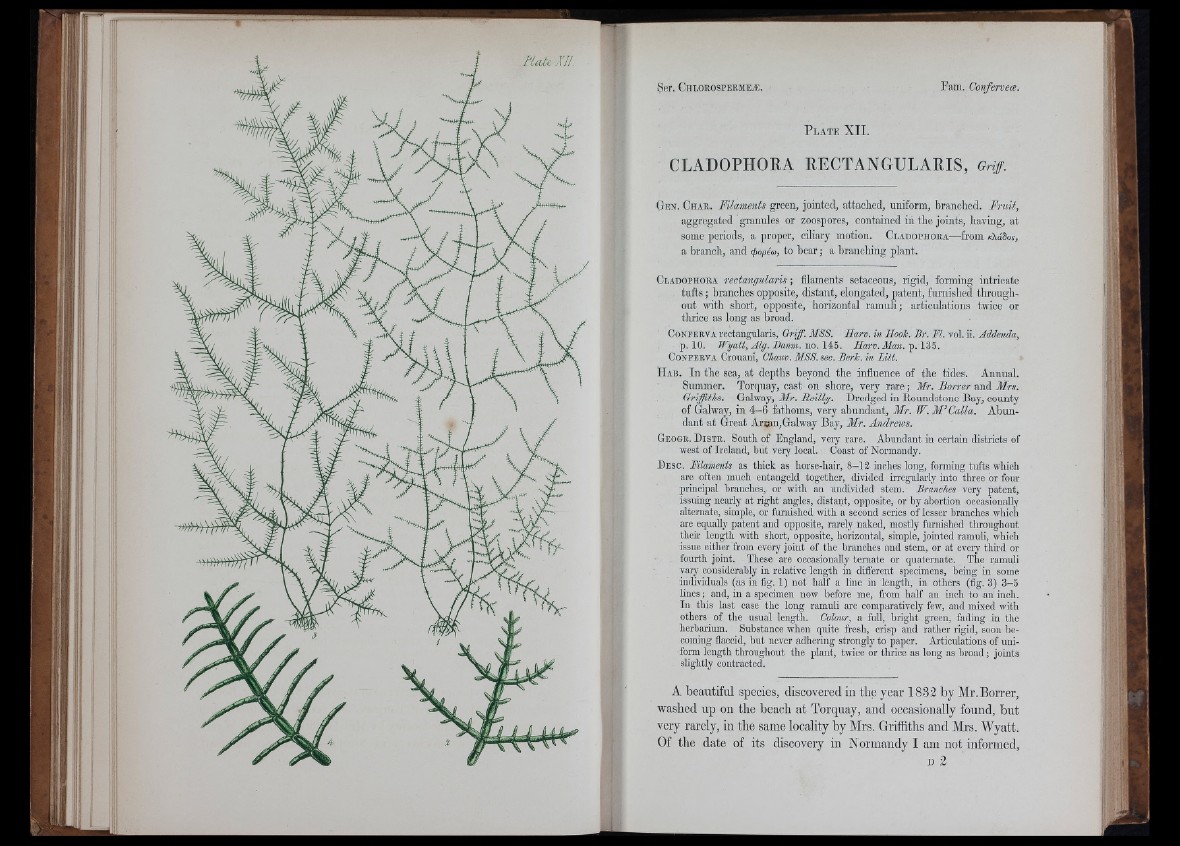
P l a t e XII.
CLADOPHORA RECTANGULARIS, Griff.
Gen. C h a r. Filaments green, jointed, attaclied, uniform, branched. Fruit,
aggregated granules or zoospores, contained in th e joints, having, at
some periods, a proper, ciliary motion. C la d o p h o r a— from sXahoi,
a branch, and <j>opto>, to b e a r ; a branching plant.
Cladophora rectangularis; filaments setaceous, rigid, forming intricate
tu fts; branches opposite, distant, elongated, patent, furnished throughout
with short, opposite, horizontal ramuli; articulations twice or
tlirioe as long as broad.
C o n f e r v a rectangularis, Griff. MSS. H a n . in Hoole. Br. FI. vol. ii. Addenda,
p. 10. Wyatt, Alg. B a nm .-0.0. Hi:. Harv. Man.
C o n fe r v a Crouaui, Chaim. MSS. sec. Berk, in Lilt.
I I a b . In the sea, at depths beyond the influence of the tides. Annual.
Summer. Torquay, cast on shore, very ra re ; Mr. Borrer and Mrs.
Griffiths. Galway, Mr. Reilly. Dredged in Eoundstone Bay, comity
of Galway, in 4 -6 fathoms, very abundant, Mr. W. M ’Calla. Abundant
at Great Arian,Galway Bay, Mr. Andrews.
G e o g r . D is t r . South of England, very rare. Abundant in certain districts of
west of Ireland, but very local. Coast of Normandy.
.De s c . Filaments as thick as horse-hair, 8-12 inches long, forming tufts which
are often much entangeld together, divided irregularly into tlnree or foiu-
principal branches, or with an undivided stem. Branches very patent,
issuing nearly at right angles, distant, opposite, or by abortion occasionally
alternate, simple, or furnished with a second series of lesser branches which
are equally patent and opposite, rarely naked, mostly furnished throughout
then- length with short, opposite, horizontal, simple, jointed ramuli, which
issue either from every joint of the branches and stem, or at every third or
fourth joint. These are occasionally temate or quaternate. The ramuli
vary considerably in relative length in different specimens, being in some
individuals (as in fig. 1) not half a line in length, in others (fig. 3) 3-5
lines; and, in a specimen now before me, from half an inch to an inch.
In this last case the long ramuli are comparatively few, and mixed with
others of the usual length. Colour, a full, bright green, fading in the
herbarium. Substance when quite fresh, crisp and rather rigid, soon becoming
flaccid, hut never adhering strongly to paper. Articulations of uniform
length tlu-oughout the plant, twice or thrice as long as broad; joints
slightly contracted.
A beautiful species, discovered in tlie year 1833 by Mr.Borrer,
washed up on the beach at Torquay, and occasionally found, but
very rarely, in the same locality liy Mrs. Griffiths and Mrs. Wyatt.
Of the date of its discovery in Normandy I am not informed,